A new $25 million wastewater treatment facility located in the District of Sechelt, a small community on B.C.’s mainland coast, is leading Canada in innovative technology borrowed from Europe that utilizes the root bacteria from plants, located in a greenhouse over treatment tanks, to cleanse effluent.
"It has now won two awards," said Maple Reinders Inc. (MRI) project director Andrew Ambrozy, P.Eng., as the wastewater centre, completed in 2015, has garnered both 2016 Federation of Canadian Municipalities and Canadian Construction Association awards.
The design-build project was completed by a MRI-led consortium which also consisted of Urban Systems Ltd. and Veolia Water Technologies Canada that had access to the Organica technology, and whose research arm is based in Budapest. The system is common in parts of Europe and Asia.
"We wanted to turn a wastewater treatment facility into a resource facility," said District of Sechelt mayor Bruce Milne, who credits the previous mayor John R. Henderson’s role in initiating and bringing forward the project that is now attracting national attention.
The discharged water that emerges from the new facility is clear as tap water and the city is determine to find revenue-generating uses for it, albeit to irrigate agriculture, wash gravel, water golf courses, landscaping or utilizing it at a district level for irrigation when stringent water restrictions emerge during the drier summer months.
The purity of the water is the reason the district rebranded the facility the district’s Sechelt Water Resource Centre. Currently the centre handles wastewater from 40 per cent of the district’s population with outlying areas homes, now on septic tanks, to be connected in the future.
Biosolids are removed from the system and sold to Salish Soils Inc., where they are mixed with other organics. The remaining water is currently discharged into the ocean until a permit is obtained and a potential buyer found for the water.
"Eventually, there will be very little wastewater going out (to the ocean outfall pipe)," said Milne.
Under Henderson’s mayoralty a project steering committee was struck.
It consisted of the Coast Community Builders Association, the Sechelt Indian Band, Sechelt council members and district staff. Project technical expertise was provided to the committee by Tetra Tech, and MHPM Project Managers Inc.
"The sustainability directive was a driving factor," said Larry Sawchyn, project manager for Tetra Tech as the steering committee shaped the criteria the plant should meet.
Previous proposals had fallen short of the council’s vision for leading-edge, sustainable technology in its 9,000-member ocean-side community and popular tourist retreat. Sawchyn said his company developed a "way of grading which team would meet the objectives" when the district’s renewed call went out for more innovative approaches.
"The nature of this innovation we have now goes well beyond what was previously proposed and we also devised the performance indicators to make sure it works.
We did not want to build the first of its kind (in Canada) that didn’t work but the first of its kind that did," he said.
With the plant only 1.5 kilometres from city centre and near a lagoon and residential homes, it also had to be noiseless, odorless and meet a LEED Gold standard.
While municipalities normally hide utilitarian buildings such as treatment plants or provide safety fencing to keep visitors away, Sawchyn said: "This project was the exact opposite." The district council wanted architecture features in the plant’s design and to attract visitors.
MRI’s Ambrozy said his design-build consortium focused on technology.
"The (sustainability) criterion was very stringent and a main focus was on innovation — they gave points for innovation," said Ambrozy.
The competition caused Ambrozy, to look at Veola’s technology and its Organica system, which used the greenhouse concept.
"We got excited about it and saw how we could turn a wastewater plant into a positive. The building architecture is a greenhouse and looks like a botanical garden rather than a wastewater plant," he said, adding he traveled to Budapest, along with process engineer Matthew Smith of Urban Systems, to visit operating systems.
Smith said during the trip to Budapest, the pair saw facilities that utilized the Organica system for cities with a population of half a million.
The Sechelt system consists of four underground tanks (each four metres deep) with raw sewage piped into the first where insoluble material is screened out as well as any grit flushed into the wastewater system.
"It then goes into the Organica system," Smith said, which is a second tank or sequencing batch reactors where the roots of the greenhouse plants extend through a growing medium into the effluent below.
"The plants (while they thrive on the nutrients in the water) do not do the break down but their roots provide the environment for advanced organisms and increase the biomass in the reactor. When you increase the biomass you increase the biodiversity and that is key," said Smith.
More complex organisms can live in the diverse environment increases and increase the effluent breakdown.
Sludge, along with any fallen roots, land on the chamber’s bottom.
The sludge is removed, dewatered, and sent to composting.
The remaining water goes through an ultra-fine membrane filtration in a third chamber and ultra-violet disinfection in a fourth.
The reclaimed water is almost indiscernible from tap water but can only be used for non-potable usages such as agricultural, industrial and parks.
Ambrozy said the construction crew faced several challenges bringing the facility on stream during the 18-month build out. "Sechelt is more remote than anyone might think," he said as building materials were either barged in or brought by ferry.
"Getting accommodation for our crew was also an issue — especially during the summer months which is tourist season."
The consortium thought it might hire much of its workforce locally to build the facility, but skilled labor was limited.
"We also had to protect the environment during the excavation and construction," he said as the facility borders onto the marsh near ocean.
The facility’s foundation and chambers are built of reinforced concrete while the greenhouse structure is steel and glass and charred cedar.
The charring provides a natural preservative and serves as a rain screen. The building features solar panels on the roof and a heat exchanger extracts heat from the effluent to use in the greenhouse. Since the pumps are located underground, they are noiseless to nearby neighbors and the any odors from the facility are mitigated by the greenhouse, which is home to some 50 plant species including a lemon tree, tomato plants, bull rushes and pussy willows.
The uniqueness of the structure has brought in other municipal representatives to view it as well as queries from the private sector such as a golf course.
"We are hoping it is going to cause a ground swell of new technology across Canada," said Ambrozy.

The District of Sechelt, a coastal B.C. town with a population of 9,000, has installed Canada’s first Organica system, a European method of utilizing plant bacteria to treat effluent in a greenhouse setting.
Photo: Maple Reinders









Recent Comments
comments for this post are closed